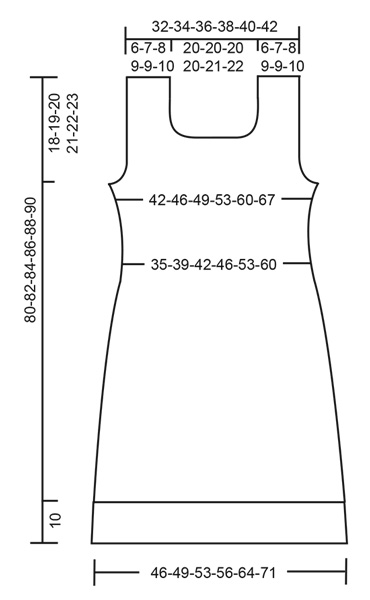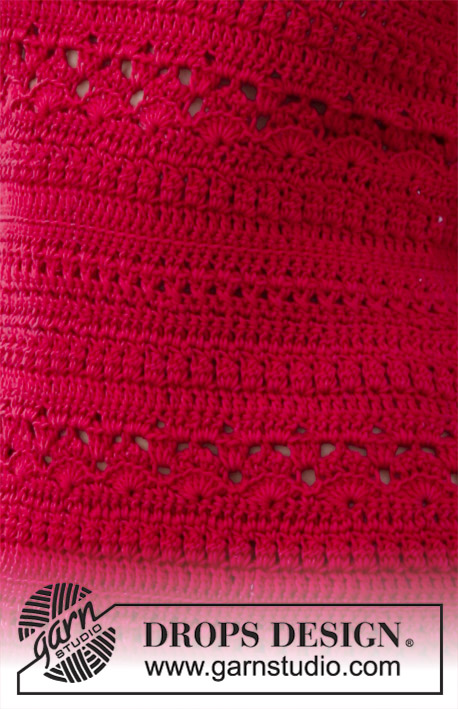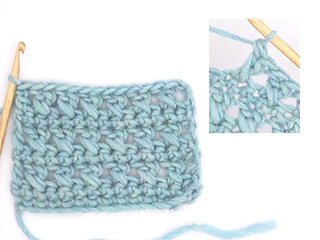Belladonna |
|||||||||||||||||||||||||||||||||||||
 |
 |
||||||||||||||||||||||||||||||||||||
Crocheted dress with texture pattern. Size: S - XXXL Piece is crocheted in DROPS Muskat.
DROPS 187-5 |
|||||||||||||||||||||||||||||||||||||
|
INFORMATION FOR PATTERN: PATTERN: See diagrams A.1, A.2 and A.3. A.2 shows how round begins/ends when working in the round. CROCHET TIP – when working back and forth: Work 3 chain stitches at the beginning of rows starting with treble crochets (does not replace first treble crochet). Work 1 chain stitch at the beginning of rows starting with double crochets (Does not replace first double crochet). DECREASE TIP: TREBLE CROCHET: Decrease 1 treble crochet by working 2 treble crochets together as follows: Work 1 treble crochet in first stitch, but wait with last yarn over and pull through (= 2 loops on hook), work 1 treble crochet in next stitch/around the chain stitch, but on last pull through pull yarn through all 3 loops on hook (= 1 treble crochet decreased). DOUBLE CROCHET: Decrease 1 double crochet by working 2 double crochets together as follows: Work 1 double crochet but wait with last yarn over and pull through (= 2 loops on hook), then work next double crochet but on last pull through, pull yarn through all 3 loops on hook (= 1 double crochet decreased) DECREASE TIP (evenly): To calculate how to decrease evenly, use the total number of stitches (e.g. 156 stitches) and divide stitches by number of decreases to be done (e.g. 6) = 26. In this example crochet approx. every 25th and 26th stitch together. -------------------------------------------------------- DRESS: There is a 10 cm vent at the bottom of dress, first work piece back and forth until vent is done, then work piece in the round but turn on every round and work back on round to make the texture the same all the way. When piece is divided at the armhole, work back and forth again. FRONT PIECE: Work 90-97-104-111-125-139 chain stitches with Muskat on hook size 4 mm. Continue with 1 double crochet in 2nd chain stitch from hook, then 1 double crochet in each of the next 4 chain stitches, * skip 1 chain stitch, 1 double crochet in each of the next 6 chain stitches *, repeat from *-* the entire row = 78-84-90-96-108-120 double crochets (chain stitch to turn with is also counted as 1 double crochet). Turn and work 1 double crochet in every double crochet. Now work according to diagram A.1 - read CROCHET TIP! REMEMBER THE CROCHET TENSION! After 10 cm put piece aside and work the back piece. BACK PIECE: Work 90-97-104-111-125-139 chain stitches with Muskat on hook size 4 mm. Continue with 1 double crochet in 2nd chain stitch from hook, then 1 double crochet in each of the next 4 chain stitches, * skip 1 chain stitch, 1 double crochet in each of the next 6 chain stitches *, repeat from *-* the entire row = 78-84-90-96-108-120 double crochets (chain stitch to turn with is also counted as 1 double crochet). Turn and work 1 double crochet in every double crochet. Now work according to diagram A.1. Continue until piece measures 10 cm - finish on the same row as on front piece. DRESS after vent: Continue pattern like this - first work stitches over front piece, then work stitch over back piece, then work round together with a slip stitch in 1st/3rd stitch on round, work stitch in A.2, turn piece and work back. Insert 1 marker thread in transitions between front and back piece = sides. Continue like this back and forth with pattern according to diagram A.1 and A.2. On rounds with treble crochets or double crochets there are now 156-168-180-192-216-240 stitches on round (A.2 is not counted in number of stitches). When piece measures approx. 30-31-32-33-34-35 cm - adjust so that next round is a round with treble crochets or double crochets (marked on diagram with star), decrease 6 stitches evenly - read DECREASE TIP and DECREASE TIP (evenly). Repeat decrease 6 times in total on the 6 marked rounds with treble crochets or double crochets = 120-132-144-156-180-204 stitches on a round with treble crochets or double crochets. After last decrease round work pattern as before for approx. 3 cm – adjust so that next round is a round marked with star (piece now measures approx. 48-49-50-51-52-53 cm). Now increase 6 stitches evenly on round by working 2 stitches in 1 stitch. Repeat increase 4 times in total vertically at the rounds marked in diagram = 144-156-168-180-204-228 stitches on a round with treble crochets or double crochets after last increase. When piece measures approx. 60-61-62-63-64-65 cm – adjust after a round marked with star, finish dress according to diagram A.3 (turn as before with diagram A.2). When piece measures 62-63-64-65-66-67 cm, divide the piece for front and back piece at the armholes. FRONT PIECE: Work slip stitches over the first 4-5-4-5-6-7 stitches, then work until 4-5-4-5-6-7 stitches remain before marker thread in the other side, turn piece. On next row work the 4 outermost stitches in each side together 2 by 2 – read DECREASE TIP! Repeat decrease on every row 0-0-1-1-2-3 more times. On next row work the 2 outermost stitches together, repeat decrease on every row 2-2-2-3-4-5 more times. After all decreases are done, 54-58-62-64-68-72 stitches remain on row. When piece measures 70-71-73-74-76-77 cm, finish each shoulder separately. SHOULDER: Continue with treble crochets over the first 17-19-21-22-23-24 stitches from the right side of piece, turn and work the first 4 stitches together 2 by 2 for neck, then work the rest of row. Turn and work until 4 stitches remain before neck, work these together 2 by 2, turn. On next row work the first 2 stitches together, then work the rest of row. Turn and work until 2 stitches remain, work these together. Turn, work the first 2 stitches together, work the rest of row = 10-12-14-15-16-17 stitches remain on shoulder. Continue until piece measures 80-82-84-86-88-90 cm, fasten off. Work the other shoulder the same way, but in reverse. I.e. Start from the right side and working the decreases for neck at end of rows from WS. BACK PIECE: Work slip stitches over the first 4-5-4-5-6-7 stitches, then work until 4-5-4-5-6-7 stitches remain before marker thread in the side, turn piece. On next row work the 4 outermost stitches in each side together 2 by 2 – read DECREASE TIP! Repeat decrease on every row 0-0-1-1-2-3 more times. On next row work the 2 outermost stitches together, repeat decrease on every row 2-2-2-3-4-5 more times. After all decreases are done, 54-58-62-64-68-72 stitches remain on row. Continue to work until piece measures approx. 78-80-82-84-86-88 cm. Then finish each shoulder separately as follows: Work 1 row over the first 12-14-16-17-18-19 stitches, turn, work the first 2 stitches together, work the rest of row. Turn and work until 2 stitches remain, work these together. Turn, work the rest of row, fasten off. Repeat on the other shoulder. ASSEMBLY: Sew shoulder seams edge to edge to avoid a chunky seam. DECORATING EDGE: Work a decorating edge around the neck, each armhole and at the bottom of body - as well as up and down each vent. Work decorating edge as follows: 1 double crochet, * 3 chain stitches, 1 treble crochet in 3rd chain stitch from hook, skip approx. 1 cm and make 1 double crochet *. Repeat from *-* and finish with 1 slip stitch in first double crochet from beginning of round. |
|||||||||||||||||||||||||||||||||||||
Diagram explanations |
|||||||||||||||||||||||||||||||||||||
|
|||||||||||||||||||||||||||||||||||||

|
|||||||||||||||||||||||||||||||||||||

|
|||||||||||||||||||||||||||||||||||||
|
Have you made this or any other of our designs? Tag your pictures in social media with #dropsdesign so we can see them! Do you need help with this pattern?You'll find tutorial videos, a Comments/Questions area and more by visiting the pattern on garnstudio.com. © 1982-2024 DROPS Design A/S. We reserve all rights. This document, including all its sub-sections, has copyrights. Read more about what you can do with our patterns at the bottom of each pattern on our site. |
|||||||||||||||||||||||||||||||||||||

























































Comments / Questions (100)
Größe M besitzt genau meine Körpergröße. Wie kann ich das Kleid später anziehen? Einfach reinschlüpfen wird nicht gehen. Müsste nicht eigentlich die linke Seite offen bleiben in taillennähe und später ein Reißverschluss eingenäht werden?
23.04.2024 - 21:47DROPS Design answered:
Liebe Carmen, Sie können vielleicht die Größe L häkeln, oder wenn Sie lieber die Größe M häkeln möchten, dann können Sie irgendein Verschluss plannen. Gerne kann sicher Ihr DROPS Händler - auch per Telefon oder per E-Mail weiterhelfen. Viel Spaß beim Häkeln!
24.04.2024 - 10:55Thank you very much ❤️. Can I also apply this to crocheting. I would like to crochet a dress with a tight fitting at the under-bust after crocheting the bust how do I decrease it so I can get a snatched look. 🙏
15.04.2024 - 00:04DROPS Design answered:
Dear Princess, this is a crochet dress, so yes, you can apply the same logic to other crochet dresses. We recommend you check the explanations for the pattern for these decrease tips whenever you work one of our pattern, since it should advise you on how to work the decreases in that specific pattern. Happy crocheting!
15.04.2024 - 00:13Please could you explain the decrease tip again. Do you mean to decrease every 25 and 26th stitch in every row
13.04.2024 - 18:14DROPS Design answered:
Dear Princess, the decrease tip is only an example; you don't need to directly apply it to the pattern, it's just to know how to calculate it. In the example, to decrease 6 stitches evenly over 156 stitches work the 25th and 26th stitches together. After the decrease, start counting from one again and decrease the next 25th and 26th stitches together again; repeat like this the whole row. Depending on the number of stitches in the size/row and the number of necessary decreases the number will change in the pattern, but the logic is the same. Happy knitting!
14.04.2024 - 23:35Hello again, thanks for the previous quick and clear answer! Now I’m wondering about attaching the two sides after the slit, I’m supposed to crotchet front side and back side, so at first there is no A2? Just keep on crotcheting to back side when finished with front row? And after doing row on both, attaching the sides with a slipt stitch? Wont the two sides end up looking different if attached different way?
08.04.2024 - 17:47DROPS Design answered:
Dear Tita, begin and end the rounds as explained with A.2, ie start with 1 / 3 chains and end the round with 1 slip stitch in the first/3rd chain stitch from beg of round. Turn ad before to continue working alternately from right side and from wrong side joining with 1 slip stitch a the end of each row. Happy crocheting!
09.04.2024 - 09:09I’m wondering about the 9th row of A.1, the treble crochet around chain stitch row. As I understand, I should have in the previoud row every other stitch a chain stitch and every other a double crotchet. The placement’s of the trebles trouble me, am I supposed to crotchet two trebles to each chain, or one to each chain and double cortchet, or am I understanding the 8th row wrong? The treble images seem to be in between stitches?
03.04.2024 - 21:00DROPS Design answered:
Dear Tita, you are talking about the 8th row of A.1 correct? The first row starts after the one with the black square, ie the one with the 3rd star, correct? On this row, crochet 2 treble crochets around each chain so that you still get 6 sts in each repeat. Happy crocheting!
04.04.2024 - 08:46Hei, på rad 9 hvor det skal være en vifte, så går det ikke opp men en hel vifte på raden. Hvor mange staver bør det være i siste vifte for at resten av arbeidet skal bli jevnt oppover?
13.12.2023 - 22:28DROPS Design answered:
Hej Marianne, viften hækles i hver 6. stangmaske :)
14.12.2023 - 08:28Quero receber receitas em crochê
30.06.2023 - 03:17Wat een mooi patroon! Ondertussen ben ik bij het voorpand onder de schouder beland waar ik de armsgaten moet gaan creëren door te minderen. Het is mij alleen niet duidelijk op welke toeren ik moet minderen (maat S). Is dit net zoals bij de rest van de jurk alleen op de toeren gemarkeerd met ster? Of moet ik gewoon een aantal toeren achter elkaar minderen? En klopt het dat ik in totaal op 4 toeren (maat S) moet minderen op dat stuk? Hartelijk dank voor uw reactie, groeten, Daphne
22.06.2023 - 23:02DROPS Design answered:
Dag Daphne,
Het minderen voor de armsgaten doe je een aantal toeren achter elkaar, zodat je echt een ronding krijgt voor het armsgat. Voor maat S staat er bij de eerste mindering (de buitenste 4 steken 2 aan 2 samen haken) dat je dit 0 keer herhaalt. Voor maat S doe je dit dus slechts 1 keer. De volgende mindering (de buitenste 2 steken 2 aan 2 samen haken) herhaal je 2 keer, dit doe je dus 3 keer in totaal voor maat S.
25.06.2023 - 18:19Stemmer oppskriften helt overens med bildet av kjolen som er vist? Det ser litt ut som om det er flere rader etter slutten av A1 (på bildet av kjolen), før mønsteret repeterer seg?
24.04.2023 - 09:37DROPS Design answered:
Hej Grethe, det kan være forskelligt i de forskellige størrelser. Men følg den størrelse som passer dig :)
24.04.2023 - 14:49Ich bin kein großer Häkelenthusiast, werde das Modell aber versuchen nachzuhäkeln, weil es so super aussieht, allerdings mag ich kein Baumwoll-/Viskosegarn verwenden, habe nachgefragt ob ich evtl. eine andere Wolle verwenden kann und wenn ja, welche. Hoffentlich schaffe ich die "Rundungen", ich stricke viel und häkle so gut wie nie, aber Stäbchen kriege ich noch hin und feste Maschen :-) LG Barbara
11.03.2023 - 15:14